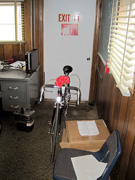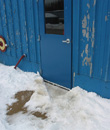Are your building exits safe?
 |
Safety inspectors at Fermilab found a bicycle obstructing this emergency exit. Exit pathways might look like unused storage space, but they are empty for a reason. |
Having an emergency exit does little good if you can't get through it.
For exits to be useful, people must be able to find and navigate through them. Fire codes govern the placement and design of these exits for the safety of the buildings' occupants. Recent safety inspections at Fermilab found some emergency exits or pathways to emergency exits that were obstructed. It is part of every person's job to make sure that exit signs, lights and pathways are working, unobstructed and up-to-date.
Exit signs — The purpose of exit signs is to guide people to the best exit pathway in the event of fire or other emergency. You have probably seen them posted at exit doors and along paths of travel. Exit signs can fall short because they are not sufficiently apparent (due to placement or number), they are misleading, or, in the case of illuminated signs, because they are not lit.
Exit lights — These help to identify the exit pathway as well as afford visibility under low-light conditions. Common problems are misdirected, broken or limited lighting.
 |
| Snow and other debris can block or partially obstruct emergency exits. |
Exit pathways — These should provide unobstructed routes that people can use for the prompt and safe evacuation of buildings. Unfortunately, the open space afforded by some exit areas can attract storage of miscellaneous items.
Most folks at Fermilab have little direct responsibility for the installation and maintenance of exit signs and lights. You should direct issues with these devices to the appropriate building manager. On the other hand, misplaced clutter is something that we can all work to remove. Please do your part to keep exit pathways clear.
-- Tim Miller, ES&H associate head
Safety Tip of the Week Archive |